It's a date
Get our L.A. Goes Out newsletter, with the week's best events, to help you explore and experience our city.
You may occasionally receive promotional content from the Los Angeles Times.
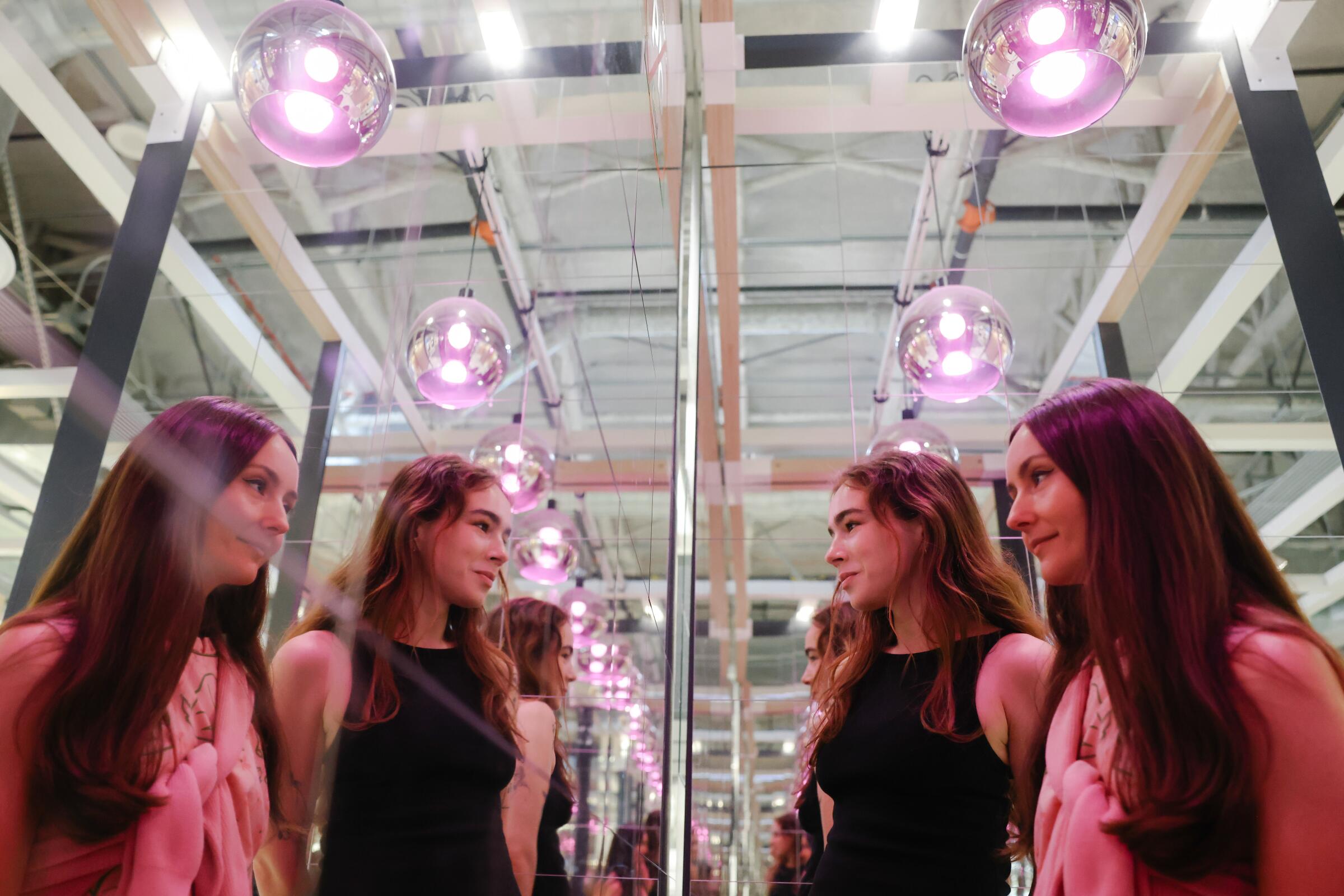
Genius Ikea hacks aren’t just for the products. Showrooms across the globe play host to first dates, birthday parties, epic games, disco naps and an eye-rolling number of pranks. But at Ikea Burbank, the mega-chain’s largest store in the nation, an underground crew is at work on a new scheme for the prefab utopia: artist’s haven.
Testing the boundaries of the three-story, 22-acre site is Ikea Residency, an unofficial (and unsanctioned) collective of artists, writers and makers in Los Angeles. The DIY set belongs to a growing creative scene remaking the disappearing “third space” — neither home nor work but somewhere in between — in their own image. They’re hungry for collaboration, creative breakthroughs and, sure, maybe some meatballs.

The experimental residency is the handiwork of Zoë Blair-Schlagenhauf and Mary Boo Anderson, artist-writers who wanted to, as they describe it on their website, “capitalize on this mecca of capitalism for more creative, authentic pursuits.” Like Ikea’s own labyrinth of possibility, their structure is more of a choose-your-own-adventure. Artists-in-residence don’t receive a stipend or live on-site; instead, they have one month and a ready-made partner within their 14-person group (a chef might be paired up with, say, a comedian, or a puppeteer with a sculptor).
“It’s funny,” Anderson adds, “they blend right in with other couples and roommates here.” After all, part of the fun of Ikea is bringing someone with you. They can create together or separately, but each resident will contribute to a group show next spring.
The rest is up to them. By design, Ikea Residency encourages getting lost in the maze. Some will search for the muse in a Billy bookcase. Others will mine it for material, flat-packed or otherwise.
“We like to joke that we have the biggest studio in America,” Blair-Schlagenhauf says. “And their art supplies are some of the most affordable I’ve seen.”
The first cohort of guerrilla artists descended on Burbank in July. One piece by Thomas Macie is still there today: pennies hammered into warehouse shelving units as a Donald Judd-style permanent installation at Ikea. Macie and his resident partner, Sophie Lynn Morris, also made Måla modeling dough casts of the fissures found on display furniture and crayon rubbings off the splintering cement floor. The idea, Blair-Schlagenhauf points out, is to “literally show the cracks in the Ikea façade.”
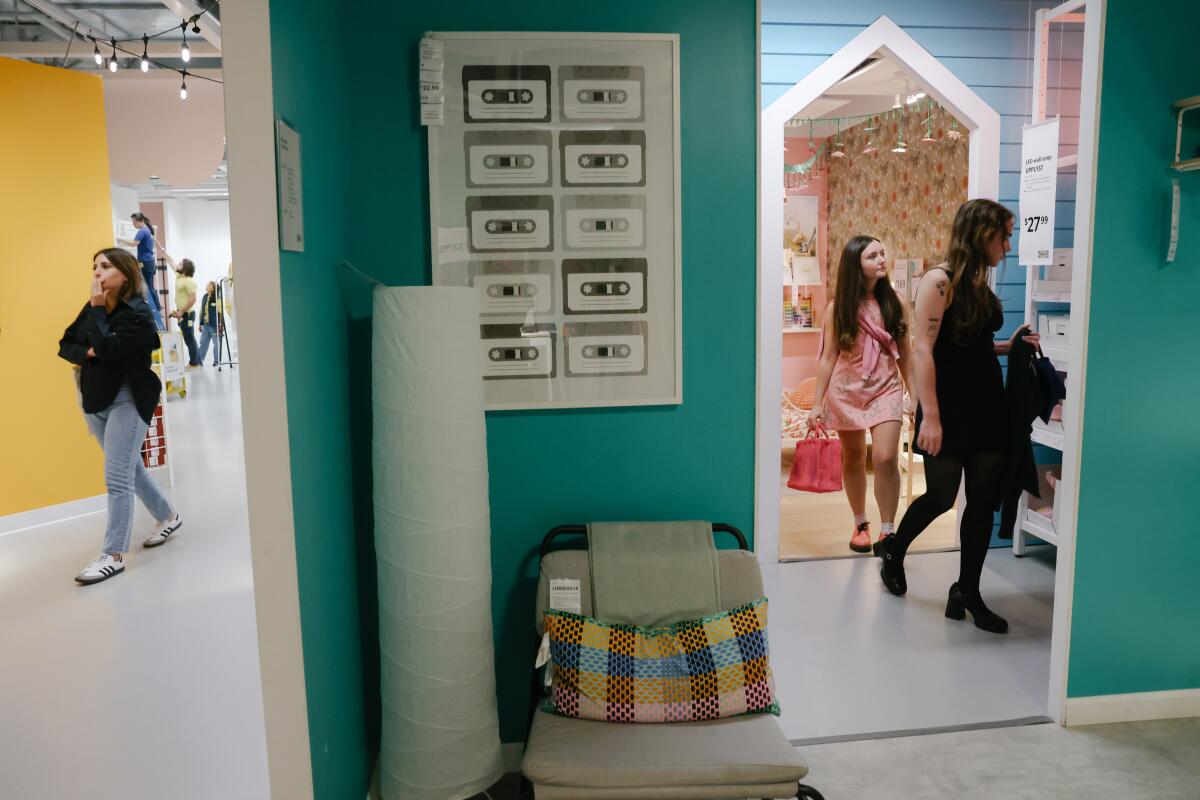
With complimentary child care, Wi-Fi and coffee (as long as you join the free Ikea Family program), Burbank’s big blue box dovetails with most co-working spaces. Walk into the sunlit, 600-seat cafeteria and you’re guaranteed to spot those Angeleno archetypes — digital nomads, content creators and the underemployed — using it as a low-key place to get stuff done.
Brian Durkin, a video editor whose work was halted during Hollywood’s strikes, stops at the cafe on a Monday morning with his paperback copy of Peter Biskind’s “Easy Riders, Raging Bulls.” He says he’d rather support a local coffee shop but needed to figure out storage for his record collection. “I’ll read my book here for, like, 40 minutes and then go on with my day,” Durkin says.
Know where to find a soothing café de olla? Or where to sing karaoke all night? How about the best spot for DTLA skyline views? Our guides are here to show you it all.
Behind him at a makeshift desk, Beth-Azmavet Estrada works on a PowerPoint presentation for her church youth group. She prefers Ikea to her school’s library and feels at home with its trademark minimal design, bathed in natural light and ambient noise.
“I love it mostly because there are other people here on their laptops,” she says. “That always kind of inspires me.” When she’s done, she’ll reward herself with a couple of small purchases on her way out.
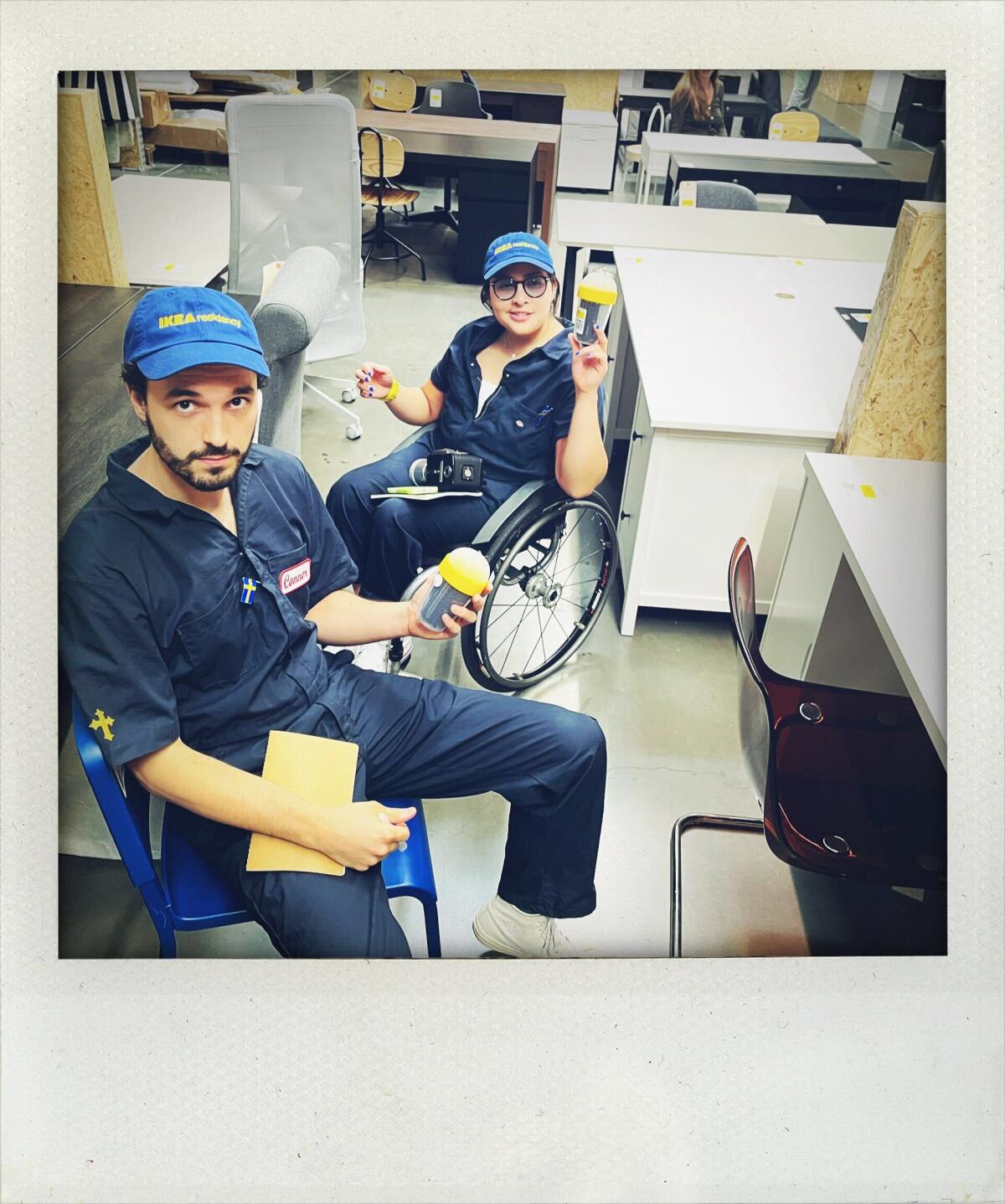
Ikea’s reputation for rendezvous is good news to Ingka Group, which owns and operates the majority of Ikea stores. It’s a testament to the brand’s principles of democratic design — form, function, quality, sustainability and low price. “That’s why we aim to create environments and meaningful brand interactions where people feel welcome, comfortable and inspired,” writes Belén Frau, Ingka Group’s global communication manager, in a statement to The Times. “After all, just last year we greeted 680 million visitors in our stores.”
Thanks to their uncanny movie-set quality, Ikea showrooms sometimes invite unwelcomed filmmakers. That’s where Swedish hospitality ends. “You can photograph in our stores, but we ask you not to film,” according to U.S. customer service.
Except in the case of the movie “(500) Days of Summer,” which shot its iconic date scene after store hours at night, the Burbank location has kicked out its fair share of actors and videographers. In 2009, a skeleton crew made a seven-part web series called “Ikea Heights,” a soap opera spoof starring future film star Randall Park. The series’ co-creator, Dave Seger, remembered staff closing the curtain on them a few times, and they ended production for fear of being arrested or, worse, banned from all Ikeas. It worked out, since Seger is now in Ikea Residency’s fall session.
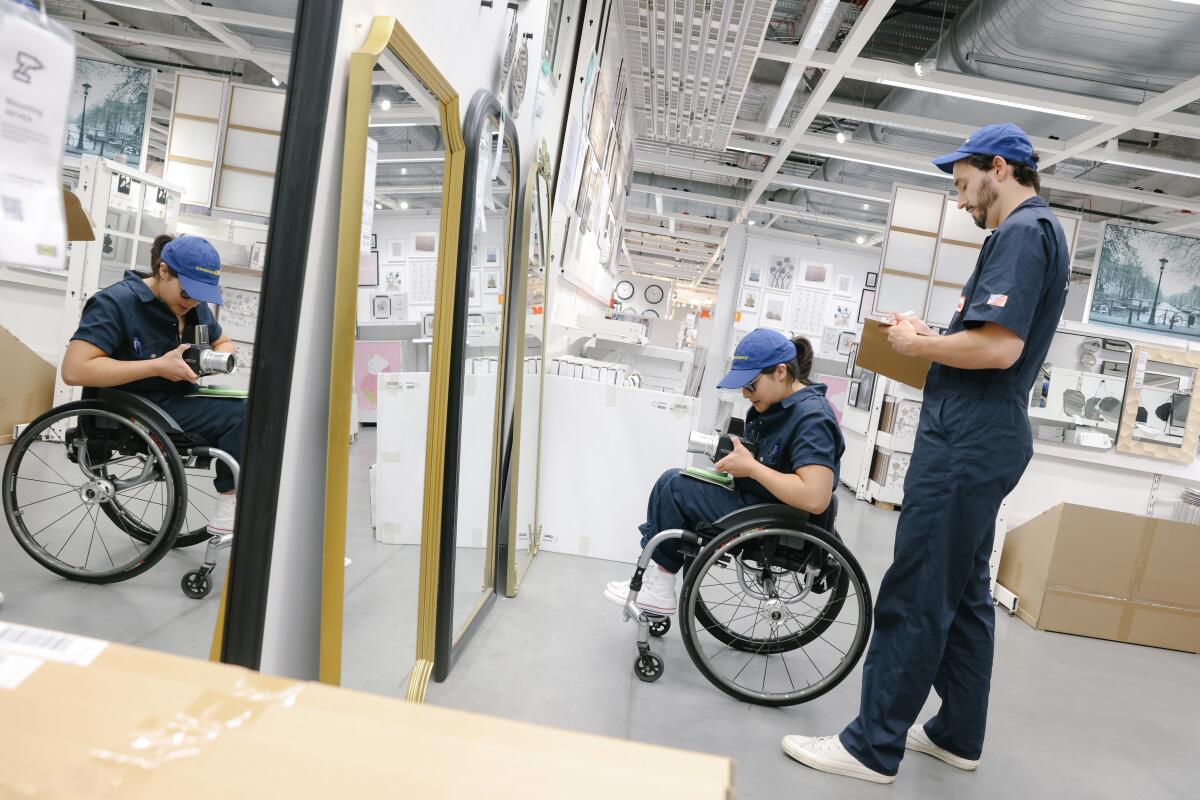
The homespun residency has no reason to believe its corporate landlords want it out, but there is a contingency plan if that should happen.
“It’s parody law,” Blair-Schlagenhauf says as a line of defense, using Nathan Fielder’s trademark-proof Dumb Starbucks stunt as a benchmark against copyright infringement. “We as an organization are very influenced by the aesthetic, but the artists themselves are definitely more interested in doing their own thing in dialogue with Ikea.”
It’s a long way from the Scandinavian furniture giant’s actual artist-in-residence program, which debuted earlier this year. The first official Ikea Artist in Residence is none other than Annie Leibovitz, the world’s most recognizable living portrait photographer. The collaboration has Leibovitz mentoring a handful of emerging shutterbugs as she “takes us on a creative journey across seven countries, capturing 25 personal portraits that reflect the authentic lives of people at home.”
For Shizuka Kusayanagi, a single mother of two boys making a career shift from graphic designer to painter, the Ikea Residency is an invitation not to escape from domesticity but rather to engage with it.
“For me, it’s really about not taking art so seriously,” she says, adding how isolated one can be as both a painter and an Angeleno. “The art world can be very crushing, so it’s really about connecting with other artists and feeling like I’m not alone.”
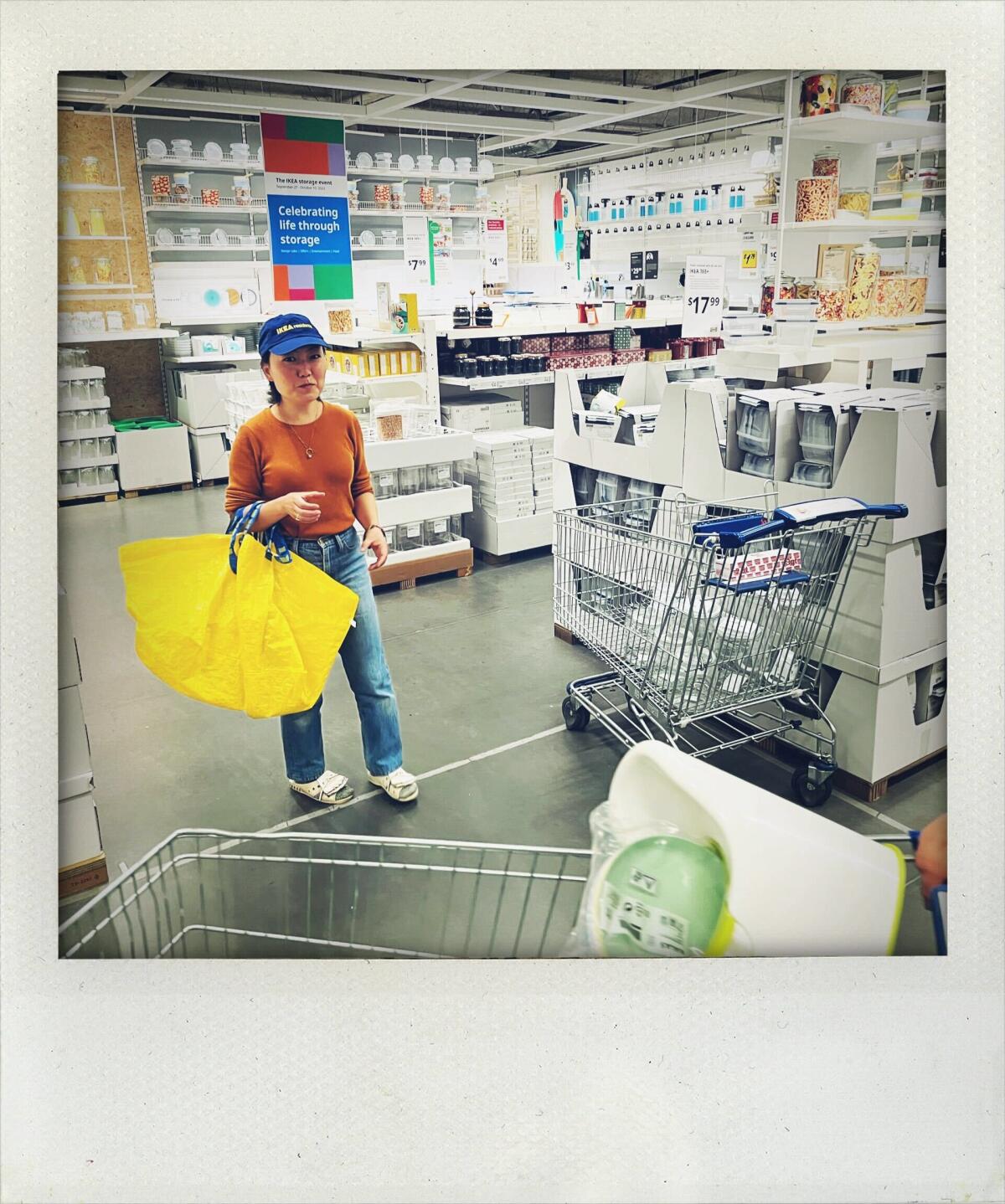
She’s paired with Angella d’Avignon, a freelance writer whose work mainly focuses on “capital-P Place.” “I’m interested in the social interactions that happen [at Ikea],” d’Avignon says, as well as “the way desire is expressed there, how interiority is made so public and visible there.” She also plans to eavesdrop on shoppers, taking a cue from Sophie Calle, the French artist who went undercover as a chambermaid to photograph hotel guests’ belongings. “I’m curious where more fights happen between couples,” she says. “Possibly the bedding section?”
Back in Burbank, partners Connor Walden and Krista Ramirez-Villatoro planted themselves inside Ikea until they hatched a plan for their October stay. Ramirez-Villatoro is a design media arts MFA student at UCLA, where “side quests” like this are encouraged. Ikea seemed “ripe for mischief,” she says. “I wanted something weird.”
The pair moseyed the budget-friendly aisles, going from consumers to culture jammers in the process. Tough for Walden, a sculptor who had just moved in with his girlfriend. “The first place we thought to go was Ikea, at least to think of ideas and dream of what’s possible,” he says. “And, of course, we bought things while we were there.” He and Ramirez-Villatoro now fixed their critical eye on the paradox of Ikea: at once aspirational and accessible, a supposed ethical conglomerate responsible for devouring 1% of the world’s lumber annually.
“It’s not quite Disney World where it’s a total fantasy,” Walden says. “But it is your own fantasy that you’re then projecting onto their display rooms.”

For most, Ikea serves as a stopgap on the way to new beginnings. To the residency’s artists, many early-career, the store offers a new lease on their creative life. To keep it going, the residency plans to be as adaptable as its namesake. It might mean changing the name to “Idea Residency,” explains Blair-Schlagenhauf and Anderson, or decamping to another big-box retailer altogether.
If anything, the pair hope Ikea Residency serves as its own artist statement.
“I hope people are inspired to make art in weird places and not wait to ask for permission,” Anderson says. “To ask themselves, where can art exist? Can I just do it myself? And can I take agency over this process that’s so heavily gate-kept most of the time.”
It's a date
Get our L.A. Goes Out newsletter, with the week's best events, to help you explore and experience our city.
You may occasionally receive promotional content from the Los Angeles Times.